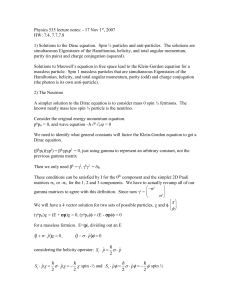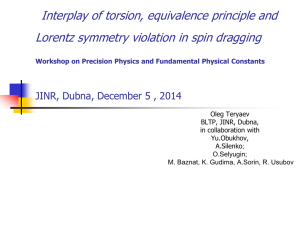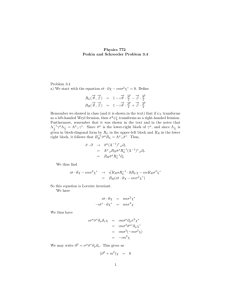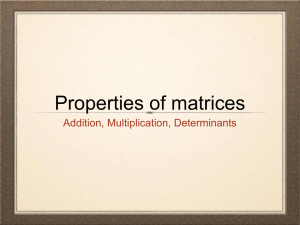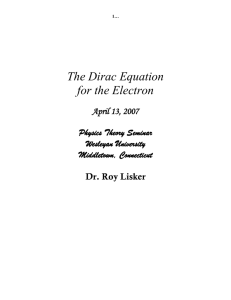Fermions and the Dirac Equation: A Quantum Physics Overview
advertisement
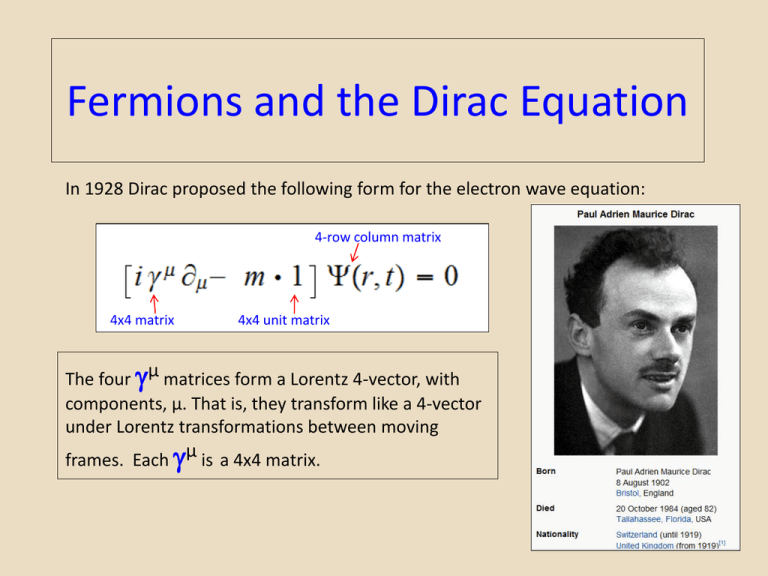
Fermions and the Dirac Equation In 1928 Dirac proposed the following form for the electron wave equation: 4-row column matrix 4x4 matrix 4x4 unit matrix The four µ matrices form a Lorentz 4-vector, with components, µ. That is, they transform like a 4-vector under Lorentz transformations between moving frames. Each µ is a 4x4 matrix. Dirac wanted an equation with only first order derivatives: But the above must satisfy the Klein=Gordon equation: This must = Klein-Gordon equation 10 conditions must be satisfies They must be 4x4 matrices! = Pauli spinors: 1 = 2 = 3 = The 0 and 1,2,3 matrices anti-commute The 1,2,3, matrices anti-commute with each other The square of the 1,2,3, matrices equal minus the unit matrix The square of the 0 matrix equals the unit matrix All of the above can be summarized in the following expression: Here gµ is not a matrix, it is a component of the inverse metric tensor. 4x4 matrices 4x4 unit matrix With the above properties for the matrices one can show that if satisfies the Dirac equation, it also satisfies the Klein Gordon equation. It takes some work. Klein-Gordon equation: 4 component column matrix 4x4 unit matrix Dirac derived the properties of the matrices by requiring that the solution to the Dirac equation also be a solution to the Klein-Gordon equation. In the process it became clear that the matrices had dimension 4x4 and that the was a column matrix with 4 rows. The Dirac equation in full matrix form 0 1 2 3 spin dependence space-time dependence After taking partial derivatives … note 2x2 blocks. p0 Writing the above as a 2x2 (each block of which is also 2x2) Incorporate the p and E into the matrices … The exponential (non-zero) can be cancelled out. Finally, we have the relationships between the upper and lower spinor components Spinors for the particle with p along z direction p along z and spin = +1/2 p along z and spin = -1/2 Spinors for the anti-particle with p along z direction p along z and spin = +1/2 p along z and spin = -1/2 Field operator for the spin ½ fermion Spinor for antiparticle with momentum p and spin s Creates antiparticle with momentum p and spin s Note: pµ pµ = m2 c2 Creates particle with momentum p and spin s r, s = 1/2 Lagrangian Density for Spin 1/2 Fermions Comments: 1. This Lagrangian density is used for all the quarks and leptons – only the masses will be different! 2. The Euler Lagrange equations, when applied to this Lagrangian density, give the Dirac Equation! 3. Note that L is a Lorentz scalar. The Euler – Lagrange equations applied to L: [ A B ] †= B † A † Dirac equation Lagrangian Density for Spin 1/2 Quarks and Leptons Now we are ready to talk about the gauge invariance that leads to the Standard Model and all its interactions. Remember a “gauge invariance” is the invariance of the above Lagrangian under transformations like e i . The physics is in the -- which can be a matrix operator and depend on x,y, z and t.



